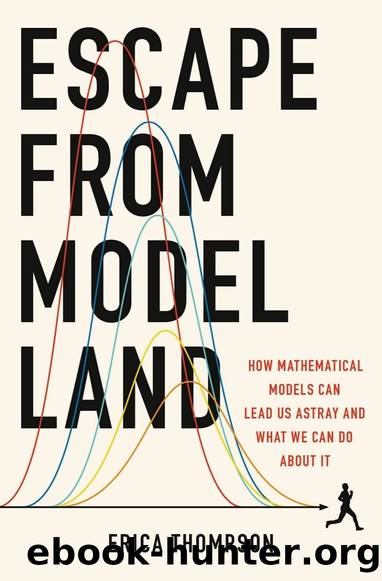Escape from Model Land: How Mathematical Models Can Lead Us Astray and What We Can Do About It by Erica Thompson

Author:Erica Thompson [Thompson, Erica]
Language: eng
Format: epub
ISBN: 9781541600997
Google: 1rJnEAAAQBAJ
Amazon: B09X5BK7RK
Barnesnoble: B09X5BK7RK
Goodreads: 63344776
Publisher: Basic Books
Published: 2022-12-06T00:00:00+00:00
The end of a performance
If the traders were âperformingâ the BlackâScholes equation into correctness â their assumptions acting as a self-fulfilling prophecy â it was a situation that could not last forever. One of the traps of Model Land is assuming that the data we have are relevant for the future we expect and that the model can therefore predict. In October 1987, the stock market crashed and market outcomes were not at all the future that was expected, nor were they consistent with any widely used model or prediction based on previously observed data. In particular, it became clear that levels of volatility in stocks are not constant, and they do not always follow convenient log-normally distributed random walks. The events of October 1987 were so far outside the range of plausible outcomes given the models in use at the time that they very effectively falsified the models.
But this crisis of confidence in markets, models and mathematics did not result in the summary ejection of the BlackâScholes equation from the tradersâ toolbox. Instead, and interestingly, it began to form a framework for discussing model imperfection. Rather than taking the straightforward approach of estimating parameters to determine an outcome (option price), the inverse perspective took the observed option price and back-calculated an âimplied volatilityâ, a quantification of the expectations about the future that were contained in the prices. Then, the implied volatility itself became the unit of comparison and the key information when making decisions, rather than the price itself. As financial economist Riccardo Rebonato nicely put it, the implied volatility became âthe wrong number to plug into the wrong formula to get the right priceâ.
The BlackâScholes model returns a constant volatility for any strike price of an option (the strike price is the price at which the option can be exercised, i.e., the pre-agreed price at which the buyer has an option to buy or sell). Before 1987, this was enforced (or performed, to use MacKenzieâs word) by the traders themselves assuming the correctness of the model. After 1987, rather than a flat line, a âvolatility smileâ emerged on plots of implied volatility, tipping upwards for options further away from the central price. That means that the equation is wrong, i.e., that the price no longer supports an assertion that changes will be log-normally distributed in future. Deviations from flatness â a âsmileâ, âsmirkâ or âskewâ â suggest different judgements being made about the way the stock will behave in future.
Having falsified one model, the temptation for any mathematically minded person is usually to construct a new, more complex model that attempts to address the failings of the first; indeed, there are more general forms of the BlackâScholes equation with different random behaviours. Yet, if all models are wrong, there is certainly something to be said for sticking with a simple one that is known to be wrong rather than a complex one that could be wrong in more obscure ways. It is interesting to see how the simpler
Download
This site does not store any files on its server. We only index and link to content provided by other sites. Please contact the content providers to delete copyright contents if any and email us, we'll remove relevant links or contents immediately.
Understandable Statistics. Concepts and Methods by Charles Henry Brase Corrinne Pellillo Brase Jason Dolor James Seibert(165)
Meat Less: The Next Food Revolution by David Julian McClements(156)
ASTROPHYSICS FOR NON-MATHEMATICIANS by Unknown(156)
Modern Physics by Gary N. Felder and Kenny M. Felder(147)
Fundamentals of Physics I by R. Shankar;(144)
A Brief Introduction to Classical Mechanics with Illustrative Problems (181 Pages) by Shahen Hacyan(131)
Calculus - Single and Multivariable 6th ed. by D. Hughes-Hallett(130)
A History of Mathematical Impossibility by Lützen Jesper;(127)
Sensory Ecology, Behaviour, and Evolution by Stevens Martin;(126)
Practical Math Success in 20 Minutes a Day by Mark A. McKibben(124)
The Parrot in the Mirror by Antone Martinho-Truswell(123)
Iraq at the Crossroads by Toby Dodge(116)
Probabilistic Risk Analysis and Bayesian Decision Theory by Marcel van Oijen & Mark Brewer(115)
B. Everitt (ed.) Encyclopedia of Statistics in Behavioral Science by Volume-2(109)
Chemistry for the IB Diploma Third edition by Christopher Talbot Chris Davison(107)
Principles of Modern Chemistry by David W. Oxtoby H.P. Gillis & Laurie J. Butler(105)
Flashes of Brilliance by Ronald L. Holle & Daile Zhang(104)
B. Everitt (ed.) Encyclopedia of Statistics in Behavioral Science by Volume-3(104)
Ethnobotany by Jose L. Martinez(103)
